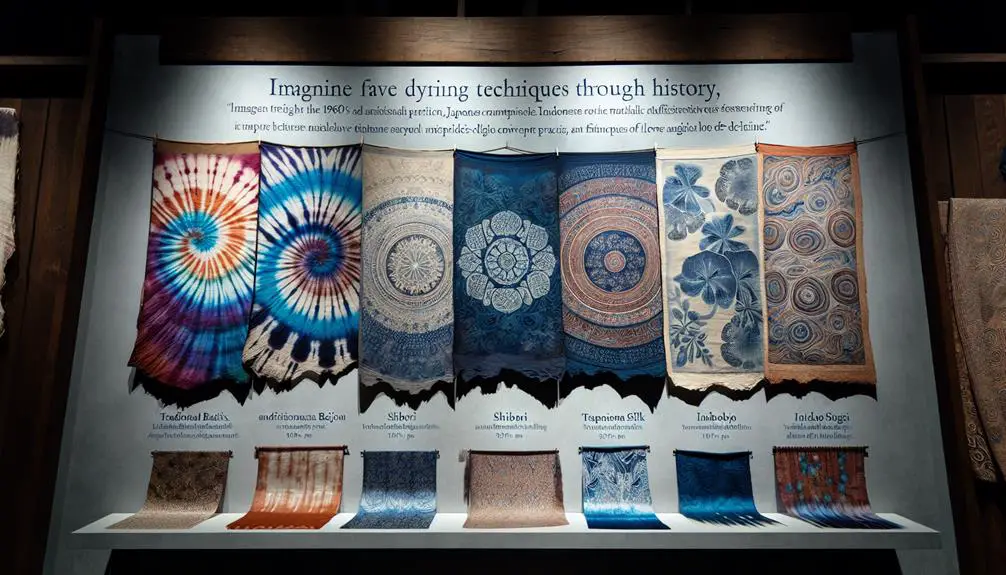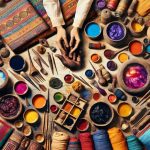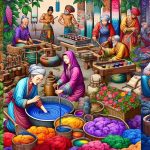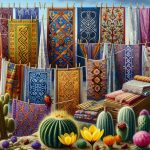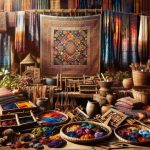Imagine you're in ancient Egypt, where artisans used indigo and madder root to dye fabrics in deep blues and reds. You'll find that the evolution of fabric dyeing techniques is a fascinating journey from these early natural dyes to the sophisticated synthetic ones used today. Throughout history, each era brought its own innovations, like the medieval introduction of mordanting with alum and the Renaissance advancements in dye extraction. As you explore these historical shifts, you'll discover how the Industrial Revolution truly transformed the textile industry. Curious about how we arrived at today's vibrant fabrics?
Table of Contents
Key Takeaways
- Ancient natural dyes utilized plants, minerals, and insects for vibrant hues and sustainable dyeing practices.
- Medieval mordanting methods with alum, iron, and tin enhanced color depth and durability in textiles.
- Renaissance dyeing saw innovations in color fastness and vibrant hues with improved mordanting techniques.
- The Industrial Revolution introduced synthetic dyes, increasing production efficiency and creating more vivid, fade-resistant colors.
- Mechanization during the Industrial Revolution enabled mass production and global trade, though it raised environmental pollution concerns.
Ancient Natural Dyes
Ancient civilizations mastered the art of creating vibrant colors using natural dyes derived from plants, minerals, and insects. If you're aiming to achieve expertise in traditional dyeing, understanding the rich history of plant-based pigments is crucial. Early artisans didn't just rely on random materials; they meticulously selected plants like madder, indigo, and woad. Each of these plants offered unique hues—madder for reds, indigo for blues, and woad for softer blue tones.
You'll find that these ancient methods involved more than just dunking fabrics into colored liquids. They required precise techniques to extract dyes from plant sources and ensure the colors bonded well with the fabric. The process was a blend of art and science, demanding a keen understanding of natural materials and their properties.
For instance, extracting indigo dye involved a fermentation process to release the pigment from the plant leaves. Traditional dyeing techniques often included multiple steps, from preparing the fabric to creating the dye bath and finally, immersing the textiles.
Medieval Mordanting Methods
When learning about medieval mordanting methods, you'll encounter common mordants like alum, iron, and tannin. These substances played a pivotal role in fixing dyes to fabrics, ensuring vibrant and long-lasting colors.
Common Medieval Mordants
Medieval dyers relied heavily on mordants like alum, iron, and tin to fix colors to their fabrics and ensure lasting vibrancy. Alum mordants were particularly popular for their ability to brighten and enhance the hues of natural dyes. When you use alum, it acts as a bridge between the dye and the fabric, creating a strong bond that secures the color remains vivid over time. This technique was essential for achieving the rich, saturated tones that were highly valued in medieval textiles.
Iron mordants, on the other hand, were commonly used to darken colors and add depth to the fabric. By incorporating iron, you could transform lighter dyes into more subdued, earthy tones, which were often sought after for their sophisticated appearance. Iron mordants also contributed to the durability of the dye, making it less likely to fade or wash out.
Tin mordants, although less common than alum and iron, were employed to produce bright, almost metallic shades. They were particularly effective with red dyes, resulting in vibrant and eye-catching fabrics. By mastering these mordanting methods, medieval dyers were able to produce a wide array of stunning, long-lasting colors that continue to inspire modern textile artists.
Dye Fixation Processes
Harnessing the power of mordants, you can secure vibrant and lasting colors on fabrics through meticulous dye fixation processes. In medieval times, achieving durable and bright textiles required a deep understanding of how mordants worked. By creating strong chemical bonds between the dye and fabric, you guaranteed the colors remained steadfast through wear and washing.
Medieval artisans used various mordanting methods that have stood the test of time:
- Heat Setting: By applying heat, you enhanced the chemical bonding between the dye and fabric. This process often involved boiling the fabric in a mordant solution before dyeing.
- Tannins: Extracted from plants, tannins were used to prepare the fabric, allowing the mordant to bind more effectively.
- Metal Salts: Compounds like alum, iron, and copper were dissolved in water to create mordant baths that facilitated robust chemical bonding.
- Sequential Mordanting: Sometimes, you'd apply multiple mordants in sequence to achieve complex colors and enhanced durability.
Mastering these medieval mordanting techniques means you can replicate the age-old tradition of producing richly colored, long-lasting fabrics. Understanding the interplay of heat setting and chemical bonding is key to elevating your dyeing practice to an art form.
Renaissance Innovations
During the Renaissance, textile artisans revolutionized fabric dyeing by experimenting with new techniques and vibrant colors. You'd find that Renaissance experimentation wasn't just about achieving brighter hues, but also about creating intricate patterns that spoke to artistic creations of the time. These artisans explored natural dyes from plants, minerals, and insects, yielding colors that were previously unimaginable.
To emphasize the importance of this era, consider the following table, which highlights key innovations and their impact:
| Innovation | Impact on Fabric Dyeing |
|---|---|
| Use of Madder Root | Introduced rich red hues |
| Indigo Cultivation | Enhanced availability of deep blues |
| Advanced Mordanting | Improved color fastness and longevity |
By mastering these techniques, you can appreciate how the Renaissance set the stage for modern dyeing practices. The use of madder root, for instance, not only introduced vibrant reds but also allowed for more stable and lasting dyes. Indigo's deep blues became a staple, while advanced mordanting processes made sure that colors remained vivid over time.
These innovations weren't just technical; they were expressions of the era's artistic spirit, influencing everything from royal garments to everyday clothing. Your appreciation of historical dyeing techniques can deepen as you understand the Renaissance's transformative role in fabric artistry.
Early Modern Techniques
Building on the Renaissance's vibrant developments, early modern techniques further refined the art of fabric dyeing with new methods and materials. You'll find that during this period, artisans began to experiment more with resist dyeing and block printing techniques, which allowed for greater precision and creativity in textile designs.
Early modern resist dyeing involved applying a resistant substance to parts of the fabric to prevent them from absorbing dye. This process created intricate patterns and vibrant contrasts in the material. You can see how this method elevated the sophistication of textile art.
Block printing techniques became increasingly popular during this time. Craftsmen would carve detailed designs into wooden blocks, apply dye to the blocks, and then press them onto the fabric. This method allowed for repeatable, complex patterns and contributed to the rise of beautifully patterned textiles.
Key advancements in early modern fabric dyeing include:
- Resist dyeing: Enhancing pattern complexity through dye resistance.
- Block printing: Achieving repeatable designs with carved wooden blocks.
- Natural dyes: Expanding the palette with new plant-based dyes.
- Metallic threads: Adding opulence with gold and silver threads.
Industrial Revolution Advances
You'll see how the Industrial Revolution transformed fabric dyeing with the invention of synthetic dyes, making vibrant colors more accessible.
Mass production methods streamlined the process, allowing for faster and more efficient dyeing.
This revolutionized the textile industry, leading to widespread changes and innovations.
Synthetic Dye Invention
The invention of synthetic dyes during the Industrial Revolution revolutionized the textile industry by providing more vibrant and durable colors. By the mid-19th century, chemists like William Henry Perkin discovered how to produce synthetic dyes, starting with mauveine. This breakthrough had an enormous impact on fabric dyeing, making previously rare and expensive colors accessible to the masses.
With synthetic dyes, you no longer needed to rely on natural sources, which were often inconsistent and limited. The new dyes offered:
- Vibrant Colors: Synthetic dyes produced more vivid and varied shades compared to natural dyes.
- Durability: Fabrics dyed with synthetic colors were more resistant to fading, even with frequent washing.
- Cost Efficiency: The production of synthetic dyes was cheaper and faster, making colorful fabrics more affordable.
- Consistency: Unlike natural dyes, synthetic dyes guaranteed uniformity in color from batch to batch.
These advancements allowed you to explore a broader palette and experiment with more intricate designs. The impact was profound, not just in fashion, but in the overall quality and production efficiency of textiles.
With synthetic dyes, you could achieve a level of mastery in fabric dyeing that was previously unattainable, setting the stage for modern textile innovations.
Mass Production Methods
During the Industrial Revolution, you witnessed the emergence of mass production methods, which significantly enhanced the efficiency and scale of fabric dyeing. This transformation was propelled by the mechanization of processes, particularly through the introduction of steam-powered machines.
You could now create dyed fabrics on a scale previously unimaginable, meeting the increasing demands of a growing global market.
However, with these advancements came significant environmental concerns. The widespread use of synthetic dyes and chemicals often resulted in pollution, impacting both ecosystems and human health.
As someone striving for expertise in this field, you recognize the significance of addressing these issues through modern applications and sustainable practices.
Implementing closed-loop systems and water treatment technologies can alleviate some of the environmental impacts. Additionally, ethical sourcing of raw materials ensures that the dyes and fabrics are manufactured under fair labor conditions, reducing the adverse social and environmental footprint.
By integrating these strategies, you contribute to a more responsible and sustainable industry.
Incorporating sustainable practices into mass production methods isn't only a trend but a necessity. By focusing on these vital aspects, you can help pave the way for a more ethical and environmentally conscious approach to fabric dyeing.
Textile Industry Impact
As mass production methods revolutionized fabric dyeing, the textile industry experienced unprecedented growth and transformation during the Industrial Revolution. You witnessed a shift from artisan craft to industrial scale, making dyed textiles more accessible and affordable. This period brought several advancements that reshaped the industry.
- Mechanization: Machines took over manual labor, boosting production speed and efficiency.
- Synthetic Dyes: The discovery of synthetic dyes replaced natural dyes, offering a broader range of vibrant colors and consistency.
- Standardization: Uniformity in fabric quality and color became possible, meeting the demands of an expanding market.
- Global Trade: Enhanced production capabilities allowed for international trade, spreading innovations worldwide.
However, this rapid expansion wasn't without its drawbacks. The textile industry faced significant environmental impact due to the introduction of synthetic dyes and the mass production processes. Pollutants from dye factories contaminated water sources, harming ecosystems and human health.
You need to take into account the balance between industrial growth and environmental sustainability. By understanding these historical advancements and their consequences, you can better appreciate the current challenges and innovations aimed at reducing the environmental footprint of the textile industry. Mastering this knowledge equips you to drive future changes in sustainable fabric dyeing practices.
Contemporary Synthetic Dyes
You might be surprised at how much synthetic dyes have revolutionized modern fabric dyeing techniques. Unlike their natural counterparts, synthetic dyes offer a more consistent and wide-ranging color palette due to their precise chemical composition.
However, this precision comes with its own set of environmental concerns. The production and disposal of synthetic dyes often involve harmful chemicals that can pollute water sources and soil. To mitigate these issues, many manufacturers are now investing in eco-friendly alternatives and advanced filtration systems.
Colorfastness is a key advantage of synthetic dyes. Once applied, these dyes are highly resistant to fading, even after multiple washes. This makes them ideal for fabrics that require long-lasting vibrancy.
Fiber compatibility is another significant benefit. Synthetic dyes can be tailored to bond effectively with a variety of fibers, from natural ones like cotton and wool to synthetic fibers like polyester and nylon. This versatility ensures that you can achieve the desired hue and intensity on almost any textile.
Frequently Asked Questions
How Can I Safely Dispose of Leftover Dye After a Dyeing Project?
To safely dispose of leftover dye, follow proper chemical disposal guidelines. Consider environmental impact by using eco-friendly waste management practices. Prioritize sustainability by researching local disposal facilities and avoid pouring dye down the drain.
What Are the Best Practices for Washing Dyed Fabrics to Prevent Color Bleeding?
To master washing dyed fabrics, start with colorfastness testing. Use cold water and gentle detergent for fabric care, ensuring dye fixation. Preventing fading is key: avoid excessive agitation and always wash similar colors together.
How Do Environmental Factors Affect the Longevity of Dyed Fabrics?
Environmental factors like sun exposure and humidity greatly affect the longevity of dyed fabrics. Proper drying techniques and understanding chemical reactions can help you preserve colors and prevent fading, ensuring your fabrics last longer.
Can Fabric Dyeing Techniques Be Used on Non-Textile Materials?
Where there's a will, there's a way. You can use fabric dyeing techniques on non-textile materials like metal surfaces and plastic items. Mastering this can transform ordinary objects into vibrant, customized creations.
What Are Some Common Mistakes to Avoid When Dyeing Fabrics at Home?
When dyeing fabrics at home, avoid common mistakes like improper fabric preparation and incorrect color mixing. Always pre-wash the fabric to remove residues and test dye colors on a small piece first to guarantee desired results.
- What Is Gore-Tex Surround Technology in Shoes? - July 2, 2025
- Haven X Converse: a Look at the Gore-Tex Collaboration - July 2, 2025
- What Is Gore-Tex Infinium and When Should You Use It? - July 2, 2025

